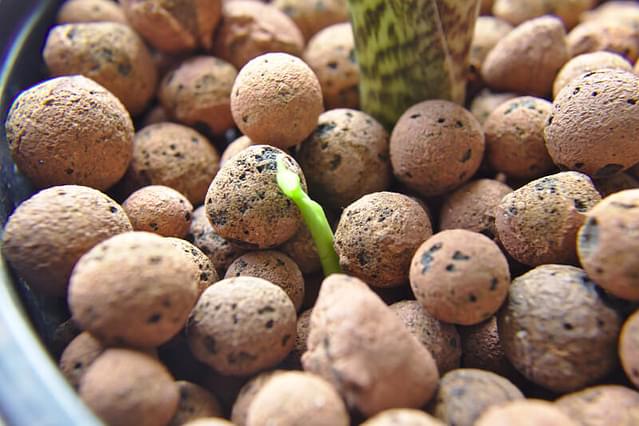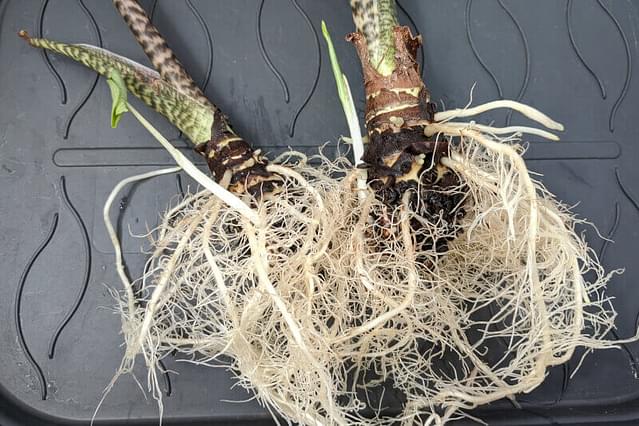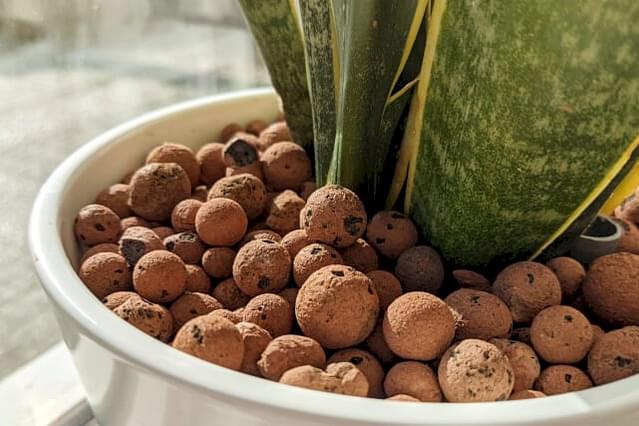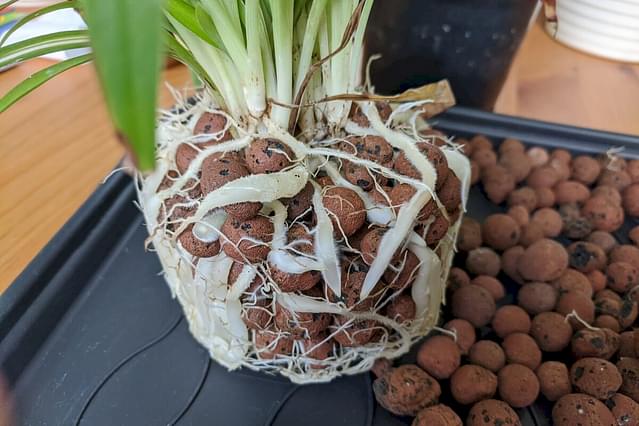What is Leca and why is it useful for plants?
adapted from Houseplantsforbeginners.com
Leca is an acronym and it stands for: Lightweight expanded clay aggregate. It sounds very complicated, but it’s quite easy to explain. Essentially, Leca is a growing medium, like soil, in which you can grow your plants. Leca is a collection of baked clay balls that expand when you soak them in water.
When you use soil, it’s very easy to feed your plants, because the soil contains nutrients. Leca on the other hand doesn’t contain any nutrients. So you might be wondering: why would you even consider using this for growing your plants? That’s what you’ll find out in this post. After reading this post, you’ll understand why it’s useful, after which you might even want to give it a try yourself.
In this guide, we’ll go over these topics:
- What exactly is Leca?
- Why is Leca useful for growing your plants?
- How do you fertilize your plants in Leca?
Let’s get right into it! I love using Leca and I want to tell you all about it!
What exactly is Leca?

Close up of an Alocasia Zebrina growing in Leca
Like I mentioned at the beginning, Leca stands for Lightweight expanded clay aggregate. In plain English, this means that you have baked clay balls that soak up a little water, after which they’ll expand slightly. The water that’s soaked up in the clay balls can be used to water plants. However, unlike soil, Leca is just a collection of clay balls and doesn’t contain any nutrients. All they do is soak up a little water and expand when they’re soaking up the water. Any nutrients your plants need, you’ll need to add into the water.
This doesn’t get you any closer to understanding why Leca is useful, so let’s change that!
Why is Leca useful for growing your plants?
Now that you know Leca is just a collection of expanding clay balls, you might be wondering how this has any benefit for your plants. So here is a list of the benefits, after which we’ll go through them, one at a time.
- It’s easier to water your plants
- Less risk of root rot
- The risks of getting pests are reduced
- You can easily “check in” on your plants
1. It’s easier to water your plants
The most important part of growing your plants in Leca is that the roots are not allowed to sit in water. When you use Leca, you can create a false bottom and raise your plants’ roots from the bottom of the pot. Then you can add your water until it’s just under the roots of the plants. Your clay balls can start to soak up the water in the pot, while keeping the roots away from the water.
Your plants can now choose for themselves how much water they want. Since your plants aren’t sitting in water all the time, like often the case with soil, they can sip on the water that has been soaked into the clay balls. If your plants are really thirsty, they will start to grow towards the water that’s at the bottom of the pot and drink directly from that.
Putting your plants in charge
The difference for plants growing in Leca, compared to plants growing in soil, is that the plant chooses when to drink. When you use Leca, you’re putting the plant in charge of taking care for itself. After all, the plant knows what it wants and needs to stay alive. When you use soil, you decide what the plant wants and needs. This can be very tough at times, especially for beginners.
2. Less risk of root rot

Clean roots on an Alocasia Zebrina in Leca
When you’re using soil, you’re watering when the soil feels dry or the plant looks a certain way. Watering is much simpler when you’re using Leca because you’re watering when the water in the pot is gone. The plant has drunk it all or the clay balls have soaked it all up. Adding additional water, even if the clay balls are still full of water, will not cause the plant to be overwatered. Your plant won’t be overwatered, because the plant chooses when to drink and how much. If you were to add more water when the soil is still soaked, you might kill the plant and over water it.
There is also less risk of root rot, because the Leca leave a lot of air gaps between the clay balls. This helps to get the needed oxygen to your plants’ roots. A very common cause of root rot is a lack of oxygen at the roots of your plants. Leca solves this problem and worrying about root rot is a thing of the past.
3. The risks of getting pests are reduced

As mentioned in the previous paragraph, you water your plants in Leca where there is no more water in the bottom of the pot. The plant will choose when to drink and avoid being over watered. Because it’s very difficult to overwater plants in this case, the chances of getting root rot are very low.
This means that bugs won’t be attracted to the rotting roots and soil. Fewer bugs mean fewer pests. Another reason why using Leca reduces pests is because unlike soil, Leca is not a live growing medium. Soil is organic matter, which nutrients and is “alive”. This means that it could also contain nutrients for insects. Insects usually carry and cause diseases for your plants, so avoiding them altogether helps you to reduced the chances of dealing with a sick plant.
In fact, two of my Alocasias, the Zebrina, and Polly, were sick and their roots were rotting. This attracted insects and this almost killed both of the plants. After switching them to Leca and cleaning them every single week, they’ve recovered and are now growing again like before. It’s safe to say that those plants will never touch soil again.
4. You can easily “check-in” on your plants

When you’re growing your plants in soil, the only time you’ll really see the roots are when you’re in the process of repotting the plant. In between planting and repotting them, you won’t really know what the roots look like and how they’re doing.
However, when you’re growing your plants in Leca, you’ll be able to look at the roots every single day if you choose so. This is not something you should actually do, because some plants don’t like change. I clean most of my plants, which grow in Leca, every week or once every two weeks. During this process, I also make sure to clean, or at least rinse, the Leca. This gives me an opportunity to have a look at how the roots of the plants are doing. The picture at the top of this post is an example of this. I can look at the progress of the roots and adjust the placement of the plant in the pot accordingly.
The fact that you can “check-in” on your plant so easily is what helped me to save my Alocasias from certain death. I was able to cut off rotting roots as soon as I saw them and prevent further rotting by cleaning the plant well. This took a lot of effort, but my plants are rewarding me by growing again.
How do you fertilize your plants in Leca?
I mentioned that Leca does not provide your plants with the nutrients they need to grow properly. Leca only takes care of watering your plants. As such, you’ll need to add nutrients to water yourself. Most general hydroponics fertilizer is fine, but there are also specific types of fertilizer you can use to help your plants. These can range from growth hormones to fertilizer to help the roots grow faster and stronger. I personally have no experience with these are stick to a general hydroponics fertilizer. This has worked well so far, so it may be something you can consider using as well.
About hydroponics nutrients (fertilizer)
Hydroponics nutrients (or fertilizer) contain special ingredients that your normal plant fertilizer don’t have. Normal plant fertilizer doesn’t need these ingredients, because the soil provides your plant with these nutrients. Since Leca doesn’t contain any nutrients by itself, the hydroponics fertilizer needs to have these to keep your plant healthy. This is the reason why you can’t use normal fertilizer for your plants in Leca, because it’s missing key ingredients.
Conclusion
Leca stands for Lightweight expanded clay aggregate. Essentially it means they’re baked clay balls that expand when you soak them in water. They’re great as a medium for plants to grow in because it makes watering your plants much easier, you reduce the risks of getting pests, and you can easily “check-in” on your plants. The most important thing you have to think about when growing your plants in Leca is to never later their roots sit in water and to add a hydroponics fertilizer of some sort to your water. This way your plants get the nutrients they need and drink when they’re thirsty. Hopefully, the benefits that I’ve listed in this post make you want to give it a try. I can highly recommend using it!
Check out the original article at:
https://plantcareforbeginners.com/articles/what-is-leca-why-useful-for-growing-plants

